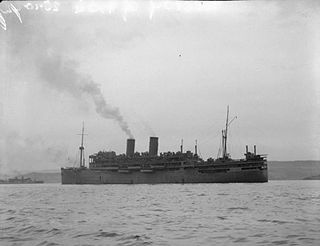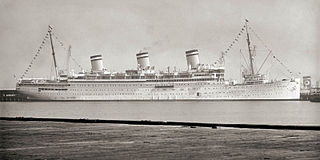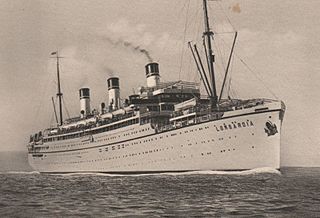
RMS Viceroy of India was an ocean liner of the Peninsular and Oriental Steam Navigation Company (P&O). She was a British Royal Mail Ship on the Tilbury–Bombay route and was named after the Viceroy of India. In World War II she was converted to and used as a troopship. She was sunk in the Mediterranean in November 1942 by German submarine U-407.
SS Antenor was a UK steam turbine passenger and refrigerated cargo liner launched in 1924. She was the third of five ships to bear the name.
SS Minnedosa was one of a pair of transatlantic steam ocean liners that were built in the United Kingdom, launched in 1917 and operated by Canadian Pacific until 1935. Her sister ship was Melita.

USS Taurus (AF-25), formerly SS San Benito, was a refrigerated banana boat of the United Fruit Company that may have been the first merchant ship to be built with turbo-electric transmission. From October 1942 to December 1945 she was a United States Navy stores ship in the Pacific Ocean theatre of World War II. She was scrapped in 1953.

USS Saturn (AK-49) was a German cargo ship, built in 1939 as ES Arauca. In 1941 before the US entered World War II, US authorities seized her and started converting her into a United States Navy stores ship. She was the sole ship of the US Navy's Saturn class. She was laid up in 1946 and scrapped in 1972.

SS California was the World's first major ocean liner built with turbo-electric transmission. When launched in 1927 she was also the largest merchant ship yet built in the US, although she was a modest size compared with the biggest European liners of her era.

SS Scharnhorst was a Norddeutscher Lloyd ocean liner, launched in 1934, completed in 1935 and made her maiden voyage on 8 May 1935. She was the first big passenger liner built by the Third Reich. Under the German merchant flag, she was the second liner named after General Gerhard J. D. von Scharnhorst. She was one of three ships on the Far Eastern route between Bremen and Yokohama; her sister ships were SS Potsdam and SS Gneisenau. These three ships were planned to shorten the journey time between Bremen and Shanghai from the usual 50 days to 34. She was trapped in Japan in September 1939 and later converted into an Imperial Japanese Navy aircraft carrier named Shinyo in 1942 and sunk by US submarine USS Spadefish in 1944.

USAT Thomas H. Barry, formerly SS Oriente, was a Ward Line ocean liner that became a United States Army troopship in the Second World War. She was intended for transfer to the United States Navy and assigned the hull number AP-45, but was not transferred and remained with the Army.
SS Manistee was an Elders & Fyffes Ltd banana boat that was launched in 1920. She was one of a numerous class of similar banana boats built for Elders & Fyffes in the 1920s.
SS Darien was a refrigerated cargo ship of the United Fruit Company. Cammell Laird of Birkenhead, England built her as MV La Marea, completing her in 1924. She had been renamed Darien by 1930 and had been re-engined from diesel to steam by 1931.

SS Antigua was a United Fruit Company passenger and refrigerated cargo liner built at Bethlehem Shipbuilding Corporation of Quincy, Massachusetts completed in 1932. She was owned by a United Fruit subsidiary, United Mail Steam Ship Company, which registered her in New York. She carried bananas from Central America to the US and passengers in both directions.
SS Musa was a refrigerated banana boat of the United Fruit Company. She was built in 1930 and still in service in 1945.
SS Orizaba was a Hamburg America Line (HAPAG) cargo ship that was built in Hamburg 1939 and wrecked off northern Norway in 1940.

SS City of Bradford was a British passenger and cargo steamship that was built in Yorkshire in 1903, renamed Donau in 1916, reverted to City of Bradford in 1919 and became Hanne in 1936.

SS Westernland was a transatlantic ocean liner that was launched as Regina in Scotland in 1917, renamed Westernland in 1929 and returned to Scotland to be scrapped in 1947. She began her career as a troop ship repatriating US troops after the Armistice of 11 November 1918. In the Second World War, Westernland served as a troop ship, repair ship and destroyer depot ship.

The Type R ship is a United States Maritime Administration (MARAD) designation for World War II refrigerated cargo ship, also called a reefer ship. The R type ship was used in World War II, Korean War, Vietnam War and the Cold War. Type R ships were used to transport perishable commodities which require temperature-controlled transportation, such as fruit, meat, fish, vegetables, dairy products and other foods. The US Maritime Commission ordered 41 new refrigerated ships for the US Navy. Because of the difficulty of building refrigerated ships only two were delivered in 1944, and just 26 were delivered in 1945 and the remainder in 1946–48. The 41 R type ships were built in four groups. Two of design types were modified type C1 ships and two were modified type C2 ships. The United Fruit Company operated many of the R type ships in World War II. The type R2-S-BV1 became the US Navy Alstede-class stores ship and the type R1-M-AV3 became the US Navy Adria-class stores ship.
MV Asiatic Prince was a motor cargo liner that was built in Germany in 1926, operated by a British shipping line, and disappeared without trace in the Pacific Ocean in 1928. When she was lost she was carrying silver bullion worth £263,000.
SS Melita was one of a pair of transatlantic steam ocean liners that were built in the United Kingdom, launched in 1917 and operated by Canadian Pacific until 1935. Her sister ship was Minnedosa.

SS Reliance was one of a pair of a pair of transatlantic steam ocean liners that were launched in 1914 in Germany for the Hamburg America Line (HAPAG), sold to a Dutch shipping line in 1916, and seized by the United States as World War I reparations in 1922. United American Lines (UAL) operated her until 1926, when HAPAG bought her back.

SS Lombardia was one of a pair of a pair of transatlantic steam ocean liners that were launched in 1914 in Germany for the Hamburg America Line (HAPAG), sold to a Dutch shipping line in 1916, and seized by the United States as World War I reparations in 1922. United American Lines (UAL) operated her until 1926, when HAPAG bought her back.











